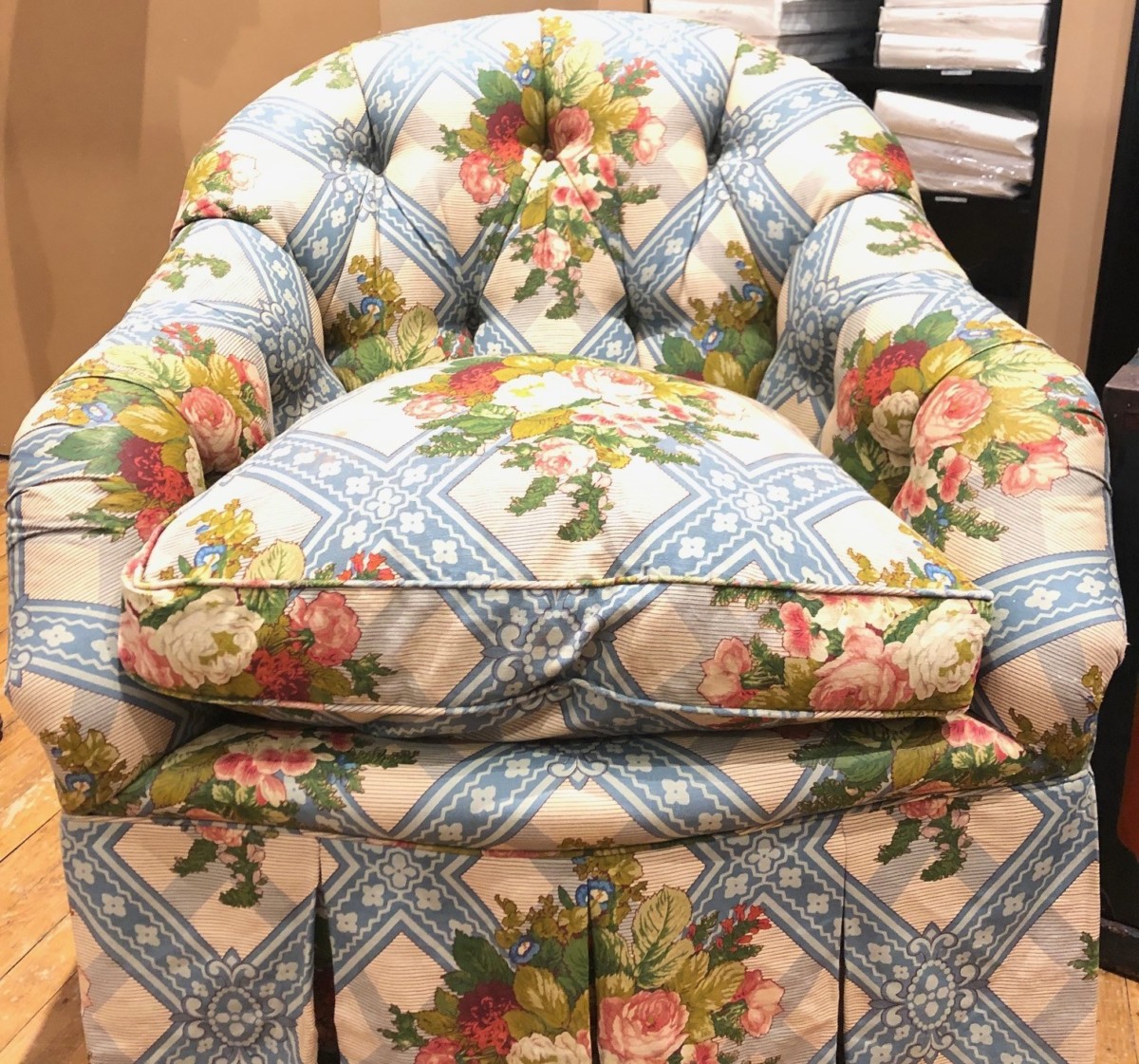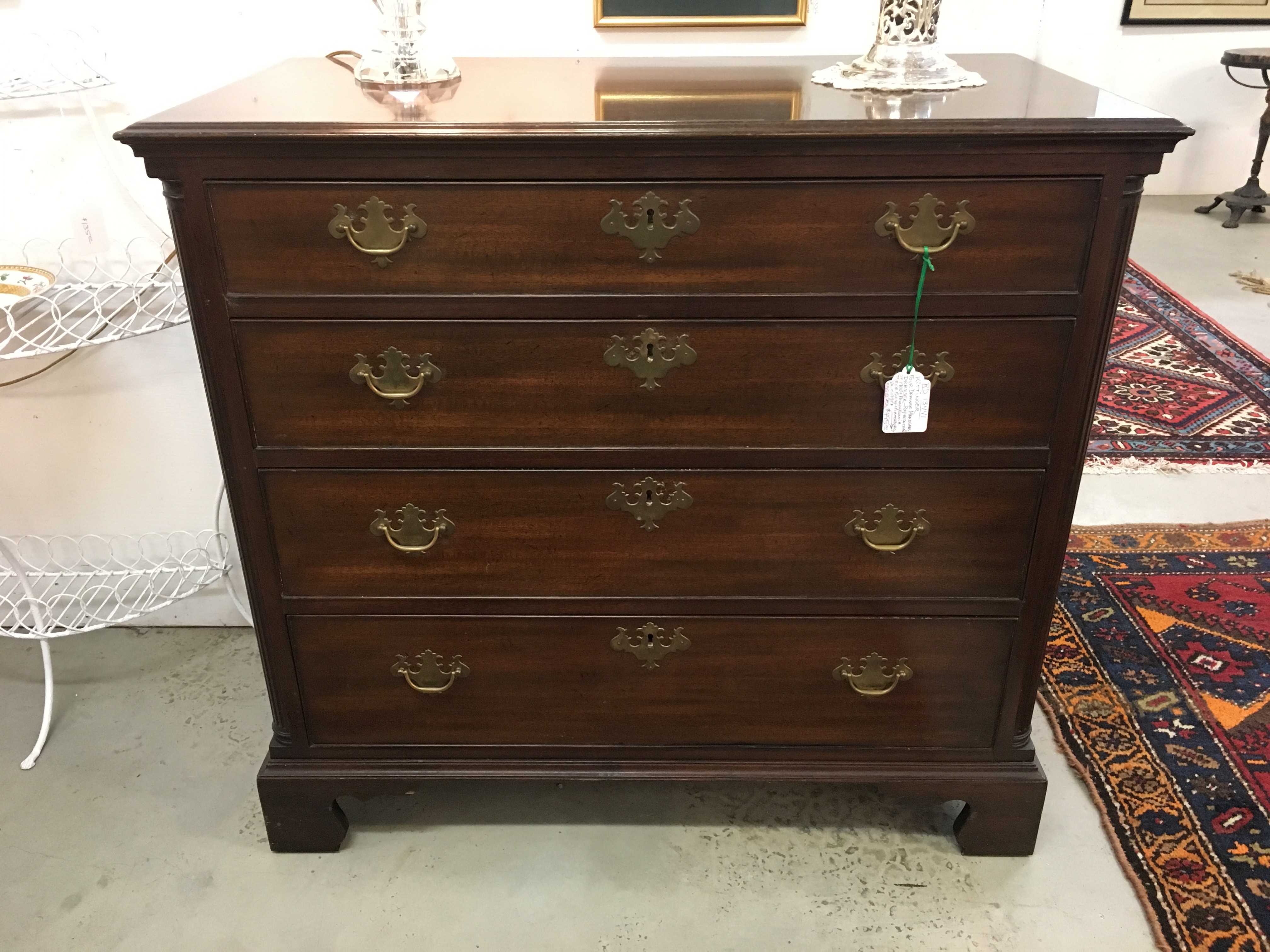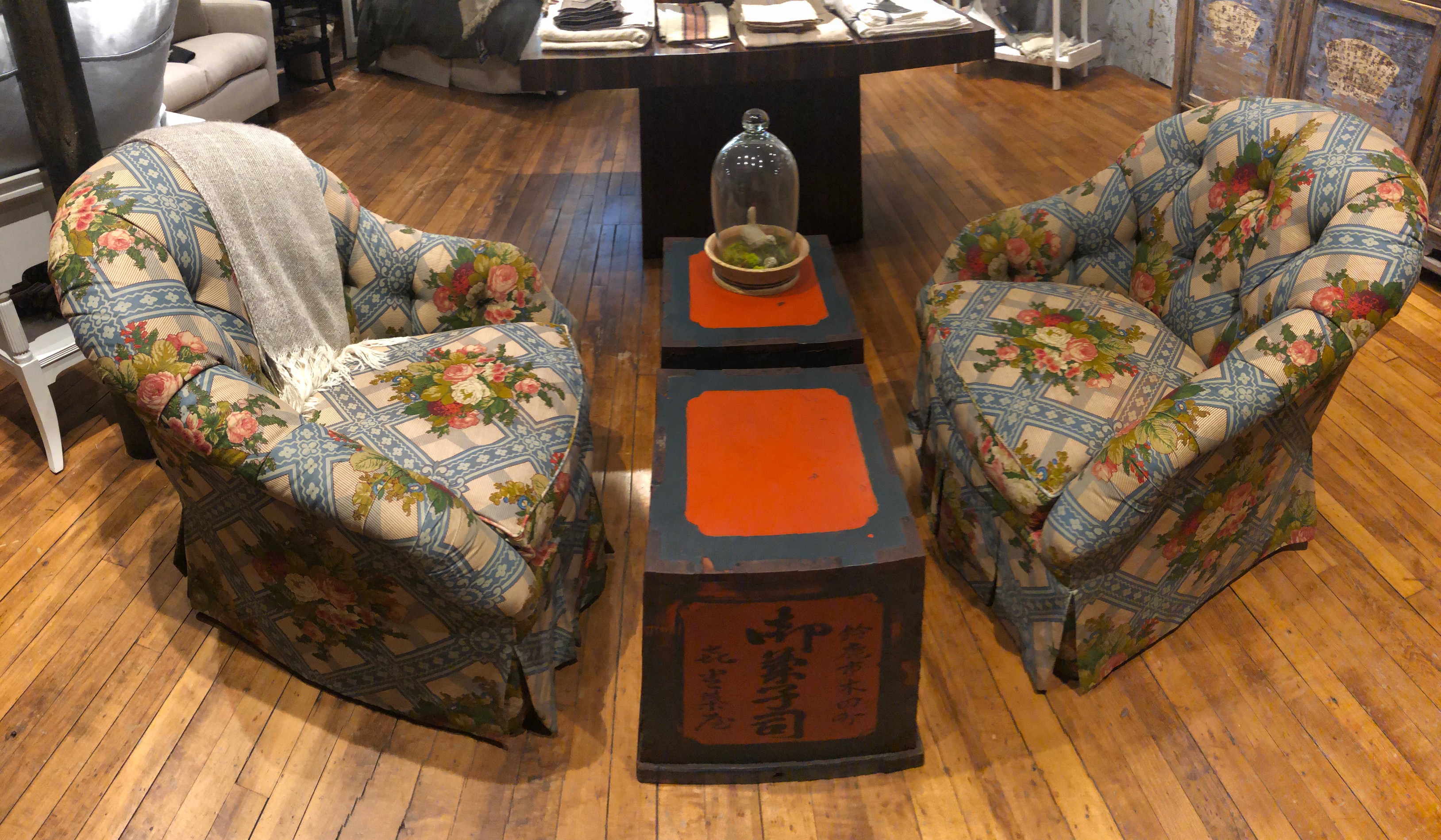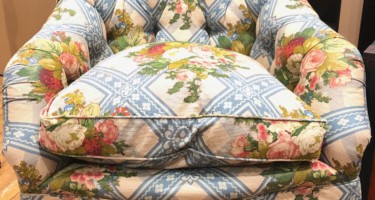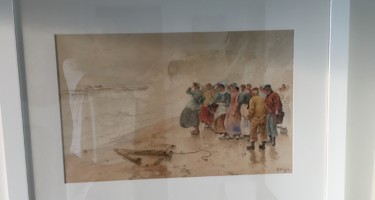So you have a bunch of “brown furniture” in your life? Great! Let’s use it!
In the 36 years since I joined the interior design industry, I have never seen such value. Brown furniture is “out” and therefore the prices have plummeted, creating tremendous opportunities. I’m not describing your parents’ 1970’s bedroom dresser, but those incredibly well-crafted, beautifully designed older furnishings and antiques that are worth a lot of money. I’m fitting them into our interior design projects on a regular basis. If you look, they are everywhere.
What’s brown furniture? Older, traditional, well-crafted, solid wood-built furniture from your grandma’s house.
Blend these durable furnishings with your contemporary decor for a big impact.
Recently, while perusing a second-hand furnishings shop, I came upon a pair of classic Brunschwig & Fils club chairs: hardwood frames, 8-way hand-tied springs, cotton-wrapped arms, down and feather seats, upholstered in a large-scale Brunschwig & Fils floral. They were priced at around 5% of what they would cost new. The wood frames alone are worth more than I paid.
What does a smart designer do with a find like this? Make a killing–right? Absolutely not! A smart designer passes the savings onto his client and positively impacts the design project’s budget. This means we now have means to augment some another finish or element that we might otherwise not have the money for.
These Brunschwig & Fils chairs were so strong that we will back into the design of a guest room using the chairs and fabric as the starting point. By combining them with complementary pieces, we have gold: a beautiful space with authenticity, a thrilled client and future projects and referrals. Everybody likes a deal — and this is an example of how we deliver value as a designer– and how you find it as a consumer).
These great “found” club chairs were picked up and taken home the same day. I didn’t have to select and order the fabric, wait for it to ship to the furniture manufacturer, wait for the manufacturer to put it into production and then wait for the common carrier to get it to the local warehouse, or schedule the delivery. Better quality, lower price, immediate availability, low impact on the environment. Did you notice how many deliveries and trucks we just cut out in a transaction?
Consumers of mass-produced, disposable “fast furniture” are missing out! Yes, such furnishings look hip and slick, they are shipped to you and you can put it together for little perceived investment. But where is the value, the authenticity and the charm? Broaden your horizons and mix in these incredible older, well-crafted furnishings. You don’t have to completely abandon your shallow bling; I don’t!
Dig through second-hand shops and look carefully. Look through the oil paintings on the floor in the bad frames—we have reframed and hung dozens of such finds. Next to a great piece of contemporary photography or a simple color study, they feel like great masterpieces, adding character and sophistication. Below, some finds now in our home.
Attainable? Absolutely. This is within reach to people at any budget. Those club chairs are part of a project with a significant budget, but they just as easily could have gone into a college dorm, because they cost less than the Ikea alternative!
Kittinger, and Wood & Hogan, were also classic high-end craftsmanship houses through the 80’s, with the best quality reproductions you could buy. The value is truly there, and more and more, I’m finding their pieces in the shops I frequent.
The two pieces below are examples of “under $500” purchases that have exponentially higher values. The Kittinger dresser is being painted and the hardware is being changed–yes, we will do that! It’s going to be a super piece for a bedroom in one of our projects.
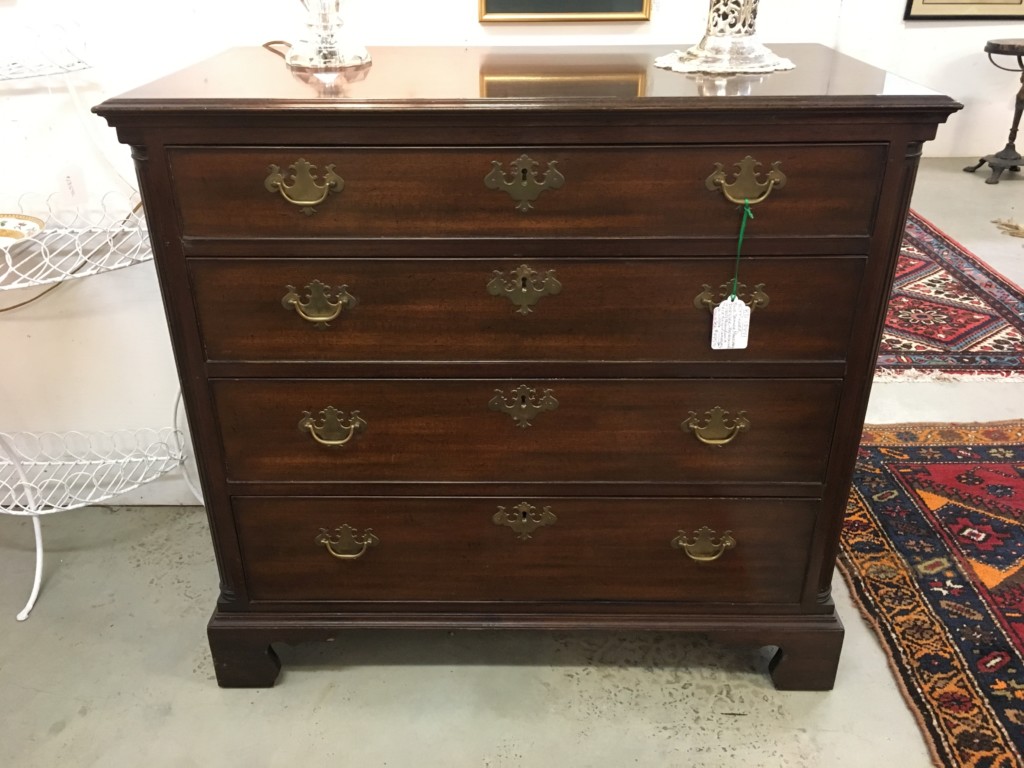
Replacing the hardware on this beautiful Kittinger dresser will bring some fresh flair to a great piece of furniture.
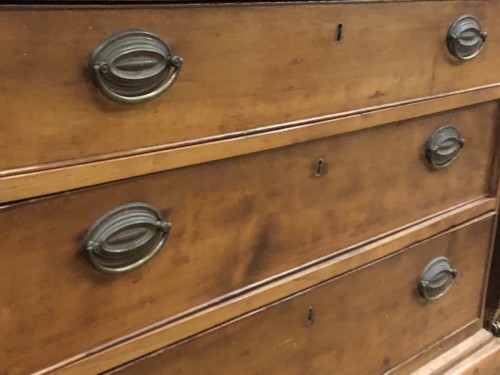
This 19th century Sheraton cherry wood dresser is another example of craftsmanship and style.
Clients ask me all the time, “Is this piece worth re-upholstering?” What–that 300-pound sofa made from particle board, sinuous springs, foam and Dacron with a good dose of formaldehyde? Absolutely not! It’s basically worthless, and re-upholstery would be throwing good money after bad.
But if the fabric on the Brunschwig & Fils chairs doesn’t work out, re-upholstery is still a great option because the construction is fabulous. Every detail is made in the authentic traditional upholstery methods honed through generations of apprenticeships.
I have furniture from my parents that I’ve reupholstered a couple of times: great forms and well worth hanging onto.
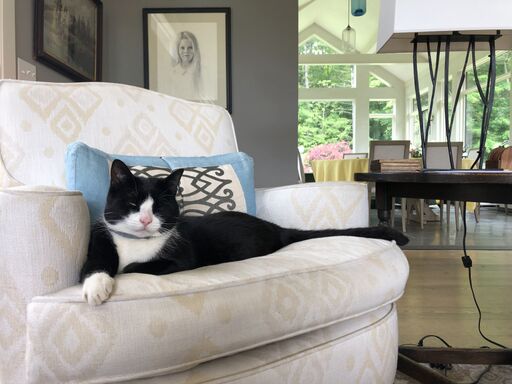
A quality-constructed chair of my mother’s, reupholstered and serving a good purpose.
Estate sales? I don’t bother. It’s too risky for me, as I’ll buy things I don’t need or can’t ultimately place, because I can’t resist the bargain. It’s much easier and safer to buy from the shops, where everything is cleaned and at least somewhat restored. Buy only what you need.
For a couple of centuries, we valued craftsmanship and authenticity in home furnishings. Dovetailed hardwood construction has given way to paint sprayed directly onto medium-density fiberboard. Today, with such aggressive trending and marketing forces in play, it’s easy to overlook these qualities. Cheap imports, opportunism and exploitation of people in many countries who are willing or forced to work for substandard compensation–it really bothers me to see their labor and the natural resources they consume in the fabrication of these products filling our landfills and oceans. Our vapid consumerism is simply wasteful.
Don’t get me wrong I’m not an extreme-left liberal, I’m not even left; I’m firmly planted in the center and find features in the left and the right politically.
Our society seems to be enamored with short-term surface bling and appearance without consideration for how this affects the future of the piece or the planet. But the harmful chemicals released by today’s mass-produced manufactured furnishings–known as “off-gassing” won’t emanate from an Empire chest of drawers! And that chest of drawers has seen itself in service for the last 210 years. That represents a wonderful use of our natural resources with zero landfill impact.
Our design decisions should go beyond transactional: we can seek out more venerable and substantive acquisitions. “What’s the least I can get it for” or “what the most I can sell it for?” should not drive our decisions.
This is not just about stuff. There’s a lot of stuff that’s just stuff. This is about finding those meaningful pieces — pieces with value, pieces with history crafted pieces that mean something to you.
Find those design jewels — they are everywhere right now! Include them with your hip/slick interior.
